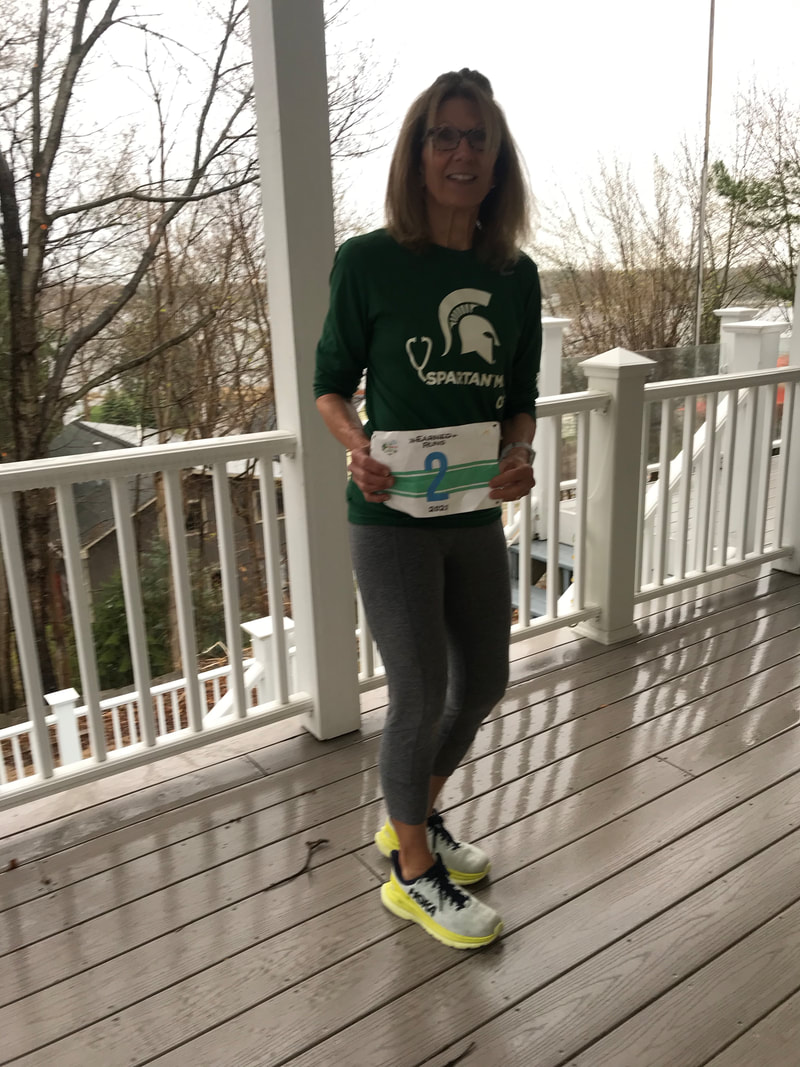BLOG
|
|
[THIS UPDATED VERSION WAS INITIALLY POSTED IN 2017. Read it this year if you haven't yet done so. Regardless of intentions to participate in an upcoming November holiday event, both runners and walkers may learn why training on a regulation track may help reach a variety of PHYSICAL ACTIVITY goals in the remainder of this year and the next.]
"IT'S YOUR MOVE! Consider training for a Thanksgiving Day Race in 2021. Unlike 2020 in which the majority of such activities were virtual, there’s a chance that this year most will be held as in-person, real-time events. CHECK OUT the Earned Runs 2021 Turkey Trot Training Plans for runners and walkers (see PDF links below or RESOURCES page). Each is designed to help first-timers prepare to participate in one of the many Thanksgiving Day events that are likely this year to be held across the USA. Not much has changed from the 2020 plans except that they are a week longer. As before, runners have the option of training on a 400-meter track one day a week. The first day of each plan is this upcoming Monday, September 13, 2021. There are a few days before a decision must be made to participate and start training. If it’s a “go”, jump right in and perform the first day’s scheduled workout, letting that experience help you commit to the full 10+ weeks leading to November 25. The running plan was adapted from one developed by Mario Fraioli for Competitor.com (now organized as PodiumRunner.com a part of Outside). The walker plan was adapted from plans offered free online by Hal Higdon. The fact that the Fraioli 5K running plan had a track day scheduled each week was one of the reasons it was selected by Earned Runs for beginners. The TRACK DAY option provides motivation to find a regulation track and take advantage of the potential benefits to be gained from feeling comfortable using one to train. The following is an updated explanation for this choice that was initially posted in 2017. “Why TRACK DAYS?” A TRACK IS A TYPE OF FITNESS EQUIPMENT Many beginning or would-be runners and walkers, may not have ever run, trained, or walked on a standard track. They may not know where the nearest or most accessible high school, college, or community facility is located. It may seem to be a training site that is off bounds to them, and more appropriately used by younger or more ‘serious’ athletes, who are fast, highly competitive, and in top physical shape. In my experience as a recreational walker/runner, there are three characteristics that make a track an essential piece of equipment that all runners and walkers should learn to consider a training ‘home’. A track is MEASURED, SAFE, and ATHLETIC. MEASURED: Specific distance assignments in a plan can be difficult to mentally assess for those accustomed to ‘just running’ or 'just walking' rather than training, especially over shorter rather than longer stretches. A GPS-assisted device can be used to chart a course in miles or kilometers but it requires repeatedly checking that device to be precise with shorter distances. Visually marking exact distances by this method to avoid such device-checking is problematic too, as rarely are there memorable physical features at needed points to help recall the start and end of a set distance. (“Which tree marks 400 meters?”). If a training plan calls for varying distances the measurement difficulties are compounded. A standard track lap or fraction of a lap is a limited distance that looks the same every time you run or walk it. Memorizing a series of landmarks isn’t required to determine the exact distance run or walked. Mentally, a standard track is nearly effortless to use. The track’s straight lengths are easily distinguished from the curved ends, each of which which can be employed for quick successive changes in pace. The time it takes to cover specific distances is relatively easy to measure on a watch or mobile device. I've found that using a track regularly for training helps my body develop a ‘memory’ for different distances. SAFE: Safety is a life quality that has several dimensions: training safety, weather safety, endurance safety, traffic safety.. Training: A running surface can be more or less safe from a training injury prevention perspective, especially when workouts will be performed at higher speeds or in adverse weather conditions. A running track used for competition tends to be even, consistent, textured, slightly cushioned, and appropriately drained. This type of surface, designed for officially certified events, is more likely than others to be safe for running faster-paced, precise intervals. Weather: Your regular road or trail running course may offer various degrees of protection from harsh elements, depending on the potential for exposure to extreme environmental conditions. Or it can leave you far from protective shelter when weather conditions are expected to deteriorate over the duration of a single long workout. On days in which the atmosphere might be hotter, colder, windier, or wetter than is desirable for performance or health, a track session may be the top safety pick. Although running or walking multiple loops of a neighborhood street course has been my preferred approach on such days, a track will do nicely when one is not readily available. On the toughest weather days, a track may beat a street course because supportive gear can be made more accessible. Hydrating fluids, nutrition, and dry, cooling or warming clothes can be stowed in a bag and left in full view at the edge of the track on bleacher seats, only a single lap away, or in a nearby parked car. Endurance: When a runner/walker is uncertain about being able to complete a given workout in its entirety, especially if longer or more difficult than previously experienced, the track can be a great place to safely test individual limits of endurance. You aren't as likely to find yourself miles from the end of tougher than expected finish during a never-before attempted session. Traffic: Personal safety in traffic is another concern of outdoor runners and walkers. Compared to busier urban thoroughfares, a track open only to foot traffic poses minimal to no risk of bodily harm from accidents caused by faster moving vehicles. Especially now that dedicated lanes near the street curb have been marked off for the use of bicycling commuters, rush hour exercise requires environmental awareness of all traffic dangers including those related to poor visibility in lowlight conditions. Some runners and walkers prefer isolated paths or suburban and country roads for avoidance of crowds. However, in cases of emergency these are places where the likelihood of receiving timely assistance from passers-by is diminished. A track can also be unsafe if in an area that is poorly lighted, out of the sight of others, or without security monitoring. Checkout the active.com article by Lauren Hargrave, which provides personal safety tips for runners. ATHLETIC: Performing a workout on a track is one way for beginners to feel and act like the athletes they aspire to become. Acquiring this mental attitude will help a runner or walker persevere in the tougher training regimens and possibly to adopt healthier eating and sleeping habits. The track is also a user-friendly place to perform pre-run dynamic stretching and mobility routines and to get in post-run static stretches as well as body-weight strength exercises (step-ups and step-downs, plank variations, and push-ups, etc) on benches and stairs. Holding to the rule that you cannot start the running/walking portion of the workout or depart from the premises before completing necessary routines increases the chances they will NOT be skipped. In some races the finish line is located on a track and the very last portion of the race includes a partial lap. Performing some workouts on a track can help beginners to visualize a successful goal race finish. Despite the encouragement of Earned Runs, the track may not be a desirable place to train for some. The Track Day Schedule identifies the approximate distances that should be run that day to help you accomplish the session goals without utilizing a track. GOOD LUCK! RUN & MOVE HAPPY! RUNNERS PLAN FREE PDF WALKERS PLAN FREE PDF 2017 TRACK DAY SCHEDULE 2017 Mintues to Miles calculations https://www.halhigdon.com/training-programs/15k-10-mile-training/intermediate-15k-10-mile/ https://www.active.com/running/articles/6-running-safety-tips
0 Comments
Your comment will be posted after it is approved.
Leave a Reply. |
BRIDGE TO PHYSICAL SELF
Running, walking, and fitness activities enable us to experience our physical selves in a world mostly accessed through use of fingers on a mobile device. AuthorEARNED RUNS is edited and authored by me, runner and founder. In 1978 I began participating in 10K road races before 5Ks were common. I've been a dietitian, practiced and taught clinical pathology, and been involved with research that utilized pathology. I am fascinated with understanding the origins of disease as well as health and longevity. Archives
November 2023
CategoriesNew! Search Box
Earned Runs is now searchable! Check it out...
|


 RSS Feed
RSS Feed